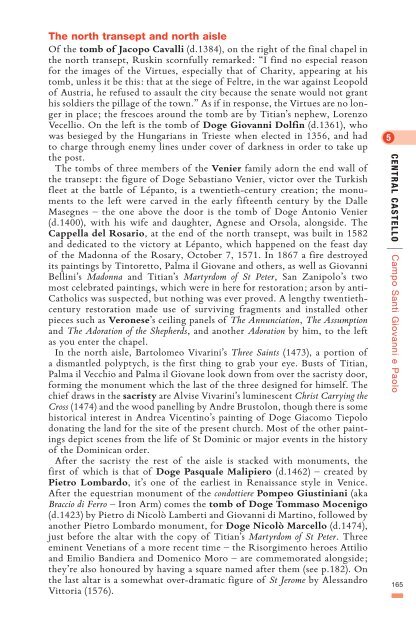You also want an ePaper? Increase the reach of your titles
YUMPU automatically turns print PDFs into web optimized ePapers that Google loves.
<strong>The</strong> north transept <strong>and</strong> north aisle<br />
Of <strong>the</strong> <strong>to</strong>mb of Jacopo Cavalli (d.1384), on <strong>the</strong> right of <strong>the</strong> final chapel in<br />
<strong>the</strong> north transept, Ruskin scornfully remarked: “I find no especial reason<br />
for <strong>the</strong> images of <strong>the</strong> Virtues, especially that of Charity, appearing at his<br />
<strong>to</strong>mb, unless it be this: that at <strong>the</strong> siege of Feltre, in <strong>the</strong> war against Leopold<br />
of Austria, he refused <strong>to</strong> assault <strong>the</strong> city because <strong>the</strong> senate would not grant<br />
his soldiers <strong>the</strong> pillage of <strong>the</strong> <strong>to</strong>wn.” As if in response, <strong>the</strong> Virtues are no longer<br />
in place; <strong>the</strong> frescoes around <strong>the</strong> <strong>to</strong>mb are by Titian’s nephew, Lorenzo<br />
Vecellio. On <strong>the</strong> left is <strong>the</strong> <strong>to</strong>mb of Doge Giovanni Dolfin (d.1361), who<br />
was besieged by <strong>the</strong> Hungarians in Trieste when elected in 1356, <strong>and</strong> had<br />
<strong>to</strong> charge through enemy lines under cover of darkness in order <strong>to</strong> take up<br />
<strong>the</strong> post.<br />
<strong>The</strong> <strong>to</strong>mbs of three members of <strong>the</strong> Venier family adorn <strong>the</strong> end wall of<br />
<strong>the</strong> transept: <strong>the</strong> figure of Doge Sebastiano Venier, vic<strong>to</strong>r over <strong>the</strong> Turkish<br />
fleet at <strong>the</strong> battle of Lépan<strong>to</strong>, is a twentieth-century creation; <strong>the</strong> monuments<br />
<strong>to</strong> <strong>the</strong> left were carved in <strong>the</strong> early fifteenth century by <strong>the</strong> Dalle<br />
Masegnes – <strong>the</strong> one above <strong>the</strong> door is <strong>the</strong> <strong>to</strong>mb of Doge An<strong>to</strong>nio Venier<br />
(d.1400), with his wife <strong>and</strong> daughter, Agnese <strong>and</strong> Orsola, alongside. <strong>The</strong><br />
Cappella del Rosario, at <strong>the</strong> end of <strong>the</strong> north transept, was built in 1582<br />
<strong>and</strong> dedicated <strong>to</strong> <strong>the</strong> vic<strong>to</strong>ry at Lépan<strong>to</strong>, which happened on <strong>the</strong> feast day<br />
of <strong>the</strong> Madonna of <strong>the</strong> Rosary, Oc<strong>to</strong>ber 7, 1571. In 1867 a fire destroyed<br />
its paintings by Tin<strong>to</strong>ret<strong>to</strong>, Palma il Giovane <strong>and</strong> o<strong>the</strong>rs, as well as Giovanni<br />
Bellini’s Madonna <strong>and</strong> Titian’s Martyrdom of St Peter, San Zanipolo’s two<br />
most celebrated paintings, which were in here for res<strong>to</strong>ration; arson by anti-<br />
Catholics was suspected, but nothing was ever proved. A lengthy twentiethcentury<br />
res<strong>to</strong>ration made use of surviving fragments <strong>and</strong> installed o<strong>the</strong>r<br />
pieces such as Veronese’s ceiling panels of <strong>The</strong> Annunciation, <strong>The</strong> Assumption<br />
<strong>and</strong> <strong>The</strong> Adoration of <strong>the</strong> Shepherds, <strong>and</strong> ano<strong>the</strong>r Adoration by him, <strong>to</strong> <strong>the</strong> left<br />
as you enter <strong>the</strong> chapel.<br />
In <strong>the</strong> north aisle, Bar<strong>to</strong>lomeo Vivarini’s Three Saints (1473), a portion of<br />
a dismantled polyptych, is <strong>the</strong> first thing <strong>to</strong> grab your eye. Busts of Titian,<br />
Palma il Vecchio <strong>and</strong> Palma il Giovane look down from over <strong>the</strong> sacristy door,<br />
forming <strong>the</strong> monument which <strong>the</strong> last of <strong>the</strong> three designed for himself. <strong>The</strong><br />
chief draws in <strong>the</strong> sacristy are Alvise Vivarini’s luminescent Christ Carrying <strong>the</strong><br />
Cross (1474) <strong>and</strong> <strong>the</strong> wood panelling by Andre Brus<strong>to</strong>lon, though <strong>the</strong>re is some<br />
his<strong>to</strong>rical interest in Andrea Vicentino’s painting of Doge Giacomo Tiepolo<br />
donating <strong>the</strong> l<strong>and</strong> for <strong>the</strong> site of <strong>the</strong> present church. Most of <strong>the</strong> o<strong>the</strong>r paintings<br />
depict scenes from <strong>the</strong> life of St Dominic or major events in <strong>the</strong> his<strong>to</strong>ry<br />
of <strong>the</strong> Dominican order.<br />
After <strong>the</strong> sacristy <strong>the</strong> rest of <strong>the</strong> aisle is stacked with monuments, <strong>the</strong><br />
first of which is that of Doge Pasquale Malipiero (d.1462) – created by<br />
Pietro Lombardo, it’s one of <strong>the</strong> earliest in Renaissance style in <strong>Venice</strong>.<br />
After <strong>the</strong> equestrian monument of <strong>the</strong> condottiere Pompeo Giustiniani (aka<br />
Braccio di Ferro – Iron Arm) comes <strong>the</strong> <strong>to</strong>mb of Doge Tommaso Mocenigo<br />
(d.1423) by Pietro di Nicolò Lamberti <strong>and</strong> Giovanni di Martino, followed by<br />
ano<strong>the</strong>r Pietro Lombardo monument, for Doge Nicolò Marcello (d.1474),<br />
just before <strong>the</strong> altar with <strong>the</strong> copy of Titian’s Martyrdom of St Peter. Three<br />
eminent Venetians of a more recent time – <strong>the</strong> Risorgimen<strong>to</strong> heroes Attilio<br />
<strong>and</strong> Emilio B<strong>and</strong>iera <strong>and</strong> Domenico Moro – are commemorated alongside;<br />
<strong>the</strong>y’re also honoured by having a square named after <strong>the</strong>m (see p.182). On<br />
<strong>the</strong> last altar is a somewhat over-dramatic figure of St Jerome by Aless<strong>and</strong>ro<br />
Vit<strong>to</strong>ria (1576).<br />
central castello Campo Santi Giovanni e Paolo<br />
|<br />
165







